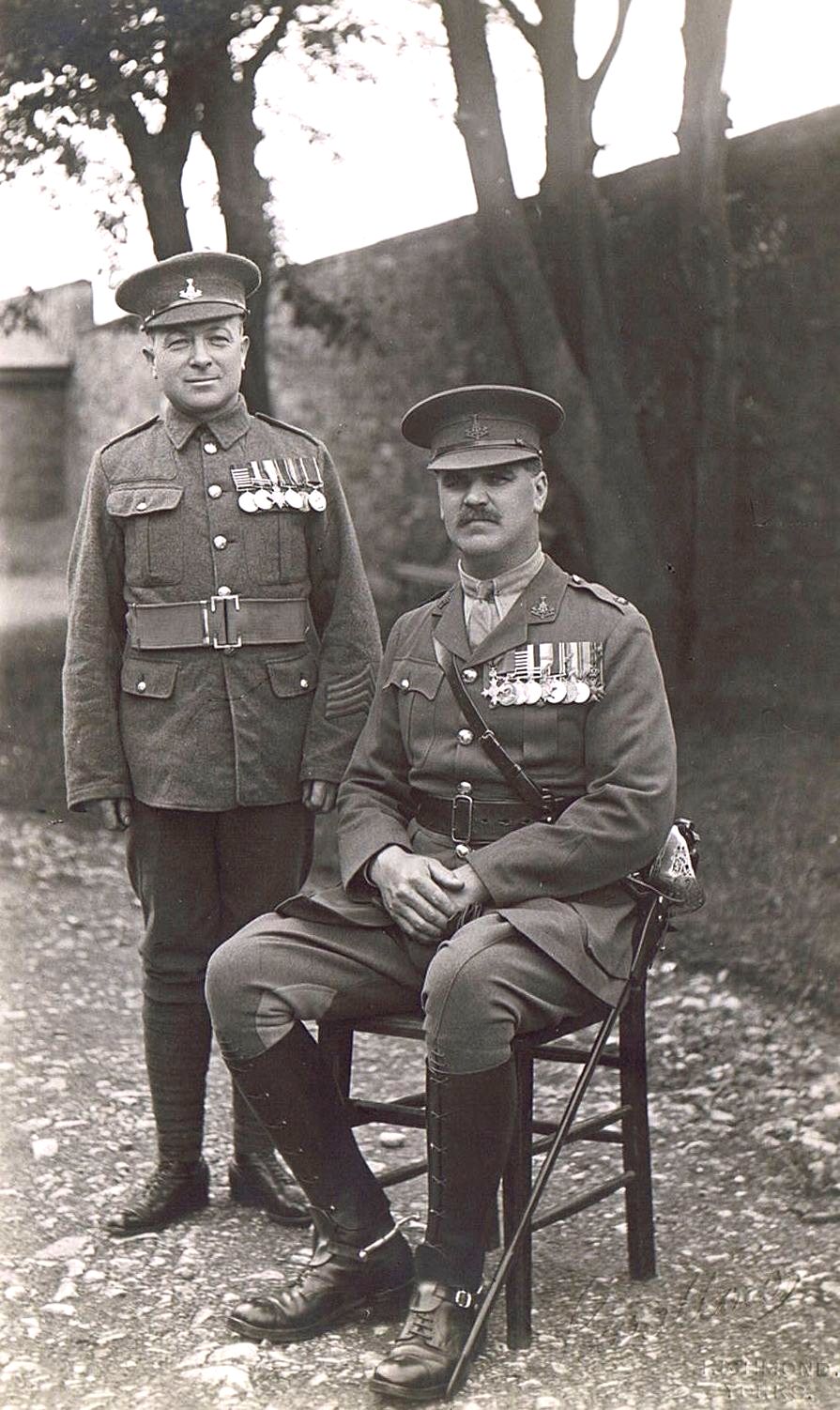
When Edward Pickard died in 1928 at the age of 56 he had given 36 years of his life to the Green Howards. Most of the town of Richmond turned out to his funeral on Friday July 21st with the mourners being headed by General Sir Edwin Bulfin, Colonel of the Regiment from 1914 to 1939.
Edward Pickard enlisted as a Green Howard in 1891, and rapidly rose through the ranks. He was one of very few officers to fight with his unit throughout the First World War, during which he served as Quarter Master to the 2nd Battalion. Pickard was the first Green Howard to fire at the enemy in the First World War – shooting two Uhlans (German mounted lancers) while trying to allocate billets to his men in Ypres! His ‘batman’ or servant, Charles Porteous Hellings who was with Pickard for a total of 14 years survived the war and is pictured here with Pickard in the grounds of the Depot in Richmond.
Explore more memories from the ribbon
-
Wilfred Whitfield
Wilfred was born in March 1896 in Marske by the Sea near Redcar on the East coast. When he was young his family moved to Middlesbrough where his father worked in the steelworks. Wilfred was training as a draughtsman when war broke out. Wilfred was just 5’ 2’’ tall, an inch shorter that the regulation height. But due to the great manpower losses he eventually got his chance in early 1915 when recruitment standards were somewhat relaxed. He enlisted in the 4th Battalion. It was in November of 1916 in the latter stages of the Somme offensive that the work party that Wilfred had volunteered for came under fire. On his way back to his own lines he was caught by a shell explosion. He was taken to a hospital at Abbeville where his left arm was amputated. Back in England Wilfred had to adjust to life without a limb. He was classed as ‘incurably unemployable’ and found it impossible to get a job. He used his time to study employment law and became a ceaseless campaigner for better conditions of his fellow jobless war wounded. He would continue to do so even when after he eventually gained employment. He was instrumental in establishing one of the first branches of BLESMA (British Limbless Ex-Servicemen’s Association) in Teesside. He married Elsie and his daughter Sylvia was born in 1932. However, his fifty cigarettes a day habit for most of his life would take their toll. He died of lung cancer in…
-
Private Alfred Arthur Hibben
Submitted by Christine Gayton Private Alfred Arthur Hibben was my great uncle Private Hibben served in his home regiment, The 1st Battalion, Queen’s Own Royal West Kent Regiment (R.W.K.). He was born in Dartford Kent and enlisted on the 1st of April 1914 at Gravesend Kent. He was 5 foot 4 inches tall, weighed 109 pounds and worked as a plumber’s mate. His age was stated as 17 years, 248 days but in fact, he was only aged 16 having been born in the last 3 months of 1898! He was posted to France on the 31st of January 1915, which still made him under the 19 years minimum required to fight abroad ( in reality he was still only 17). On the 22nd of July 1916 the 1st R.W.K. attacked the south east corner of High Wood. No significant gains were made in this assault but the R.W.K. suffered 420 casualties, approximately 50% of those who went over the top. Private Alfred Arthur Hibben was one of these soldiers and was therefore presumed killed on the 22nd of July 1916 aged 18 years. His body was not recovered but he is commemorated on the Thiepval Memorial Pier and Face 11C, France. The photograph shows Alfred aged 2 with his parents Arthur and Elizabeth and baby sister Ivy.
-
Henry Robinson
Kevin Robinson of Dalton on Tees visited the Green Howards museum to tell us about his great great grandfather, Sergeant Henry Robinson MM. Henry joined the Yorkshire Regiment (the Green Howards) as a very young man and soon left the UK to serve in the Boer War. Henry had several service numbers during his career with the earliest (and therefore a low number) being 421. On returning from the Boer war he then went to serve in the First World War both in France and Belgium, Henry and his division engaged in 2nd & 3rd Battle of Ypres, 1st & 2nd Battle of the Somme and the Battle of Arras to name a few. He is believed to have been a very accomplished horseman. His army career spanned some 4 decades as a Territorial reservist. During this time he picked up a proud chest-full of medals including the Military Medal awarded 10th October 1916. Adding a Bar to his MM in October 1918, other medals believed to be Queens South Africa Medal, 1914 Star, British War Medal, and Victory Medal with Oak Leaf (Mentioned in Despatches). Henry was also a Hero when not serving his country he was serving children with fun, Henry and his wife Elvira lived in a motor home at Derby Street / Cooper Street / Canon Street Common in Middlesbrough. They operated several fun fair rides which included swing boats and a roundabout. They continued to run the fun fair rides for several decades into the…
